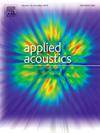Acoustic muffling of the Sonic Black Holes
IF 3.4
2区 物理与天体物理
Q1 ACOUSTICS
引用次数: 0
Abstract
Despite the growing interest in Sonic Black Holes (SBHs), existing research predominantly focuses on their sound absorption properties. However, real-life SBH structures, which consist of a finite number of concentric rings, inherently involve both sound absorption and reflection, which differ from the ideal SBHs designed for perfect absorption. Exploration of the muffling characteristics as well as the underlying mechanisms of SBHs are scarce, leaving their properties and underlying principles remain unclear. To bridge this gap, the above issues are investigated numerically and experimentally in this paper, in the context of a linear SBH connected to the main duct as a side branch. Numerical analyses reveal that SBH demonstrates multi-peak, broadband muffling characteristics, and outperforms the muffling performance of traditional quarter-wavelength tube. It was found that when the sound pressure distribution inside the SBH roughly matches odd quarter wavelengths pattern, both the absorption and reflection effects are maximized, resulting in the occurrence of muffling peaks. The SBH induced slow wave effect lowers muffling peak frequencies, creating multiple muffling peaks within the analyzed frequency band. The internal thermal-viscous dissipation effect ensures the broadband muffling performance. The numerically predicted noise attenuation results are validated through comparisons with experimental measurements. While shedding light on the underlying sound attenuation mechanisms, this study leverages the combined effects of partial absorption, reflection, cavity resonances and slow wave phenomena in practical SBHs to develop compact, broadband, low-frequency silencers, providing practical guidelines for future SBH-based muffler designs.
声波黑洞的消声
尽管人们对声波黑洞(SBHs)的兴趣日益浓厚,但现有的研究主要集中在它们的吸声特性上。然而,现实生活中的SBH结构由有限数量的同心圆环组成,固有地涉及吸声和反射,这与为完美吸收而设计的理想SBH不同。目前,对sbb的消声特性和潜在机制的探索还很少,因此它们的性质和基本原理仍然不清楚。为了弥合这一差距,上述问题在本文中进行了数值和实验研究,在连接到主管道作为侧分支的线性SBH的背景下。数值分析表明,SBH具有多峰、宽带消声特性,优于传统四分之一波长管的消声性能。研究发现,当SBH内部声压分布大致符合奇数四分之一波长模式时,吸收和反射效果都达到最大,导致消声峰的出现。SBH诱导的慢波效应降低了消声峰值频率,在分析的频带内产生多个消声峰值。内部热粘耗散效应保证了宽带消声性能。通过与实验测量值的比较,验证了数值预测的降噪结果。在揭示潜在的消声机制的同时,本研究利用实际sbh中的部分吸收、反射、腔共振和慢波现象的综合效应,开发出紧凑、宽带、低频的消声器,为未来基于sbh的消声器设计提供实用指导。
本文章由计算机程序翻译,如有差异,请以英文原文为准。
求助全文
约1分钟内获得全文
求助全文
来源期刊

Applied Acoustics
物理-声学
CiteScore
7.40
自引率
11.80%
发文量
618
审稿时长
7.5 months
期刊介绍:
Since its launch in 1968, Applied Acoustics has been publishing high quality research papers providing state-of-the-art coverage of research findings for engineers and scientists involved in applications of acoustics in the widest sense.
Applied Acoustics looks not only at recent developments in the understanding of acoustics but also at ways of exploiting that understanding. The Journal aims to encourage the exchange of practical experience through publication and in so doing creates a fund of technological information that can be used for solving related problems. The presentation of information in graphical or tabular form is especially encouraged. If a report of a mathematical development is a necessary part of a paper it is important to ensure that it is there only as an integral part of a practical solution to a problem and is supported by data. Applied Acoustics encourages the exchange of practical experience in the following ways: • Complete Papers • Short Technical Notes • Review Articles; and thereby provides a wealth of technological information that can be used to solve related problems.
Manuscripts that address all fields of applications of acoustics ranging from medicine and NDT to the environment and buildings are welcome.
 求助内容:
求助内容: 应助结果提醒方式:
应助结果提醒方式:


